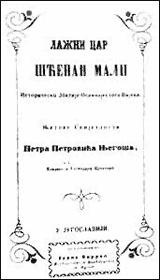Šćepan Mali
Šćepan Mali ( Serbian - Cyrillic Шћепан Мали , German: Stefan the Little; † 1773 ) was the ruler of a relatively independent Montenegro from 1767 until his death . In literature he also received the name deceptive tsar (Serbian: лажни цар / lažni car), since he himself as the Russian tsar Peter III. issued and was thereby raised to the regent of Montenegro.
Life
After the assassination of the Russian Tsar Peter III. In 1762 rumors persisted among the population that the Tsar had escaped the assassination attempt and had fled to Montenegro. Šćepan Mali, who looked similar to this, is said to have been adept at doing this, it remains unclear whether deliberately or without seriousness, pushed the rumors until he finally revealed himself openly as Tsar of Russia. He probably originally came from the west, from Dalmatia, and settled in Maine , a small town near Budva , and was a herb collector. Šćepan Mali is said to have given different information about his origin in his own statements. Only his nickname Šćepan Mali is known for his identity. In the monastery near Maine there was a tsar Peter III. More or less well depicting painting that by a comparison with the view of Šćepan Mali could probably confirm his assertion. Occasionally the apparently hopeless political, military and financial situation of Montenegro at that time between the unbelieving foreigners, on the one hand the Muslim Ottomans, on the other the Roman Catholic Venetians, which the inhabitants of the encircled country were aware of, played a role. He quickly became popular as a bearer of hope. His popularity was also due to the strongly pronounced Russophile basic attitude of the Montenegrin population, which was prevalent at this time of turmoil, so great that even Prince Bishop Sava II. Petrović-Njegoš , his co-regent and actually ruling agile brother Vasilije unexpectedly probably did so in 1766 had lost unnatural perish in Moscow, in his wisdom failed to claim the worldly influence that the prince-bishops had hitherto taken for themselves. In 1767 Šćepan Mali was recognized as regent by the aristocracy and the people.
Šćepan Mali quickly developed into an absolutist ruler, which did little damage to his popularity as the supposed Russian tsar, who ruled in person in Montenegro and stretched out his protective hand over the small country. Nevertheless, he was always concerned about the needs and needs of his subjects, who guaranteed him his integrity through their position on himself. With popular measures, such as military pranks against the Ottomans with his largely loyal bodyguard, a price cap for grain, very harsh penalties for theft and the establishment of a certain order in the then very archaic society of Montenegro, such as by the relentless pursuit and enforcement of the death penalty in murder and manslaughter, especially in cases of blood revenge , he continuously secured his good reputation and thus his position as regent of Montenegro.

Facsimile of the first edition of the drama The Deceptive Tsar Šćepan Mali by Petar II. Petrović-Njegoš from 1851 in Trieste
|
Of course, as the supposed Russian tsar, he came into the focus of power centers around Montenegro, but also that of tsarina Catherine II. One year after his appointment as regent of Montenegro, his military pranks and successes led to the Ottoman sultan about 50,000 in May 1768 A strong force, about as numerous as the population of Montenegro at that time, sent out to arrest Šćepan Mali, probably more out of fear that the Orthodox population in the area occupied by the Ottomans could encourage larger uprisings. However, he managed to evade arrest and the huge armed forces had to withdraw from the unreal region for these dimensions. At first he also escaped murder plots, also on the part of the Venetian Republic , which also had to fear unrest among the Orthodox population in their territory. Finally, the Tsarina sent Katerina II, probably also for her authority as Tsarina and widow of the murdered real Tsar Peter III. worried in their empire to overthrow a prince named Juri Vladimirovič Dolgorukov (Russian-Cyrillic: Юрий Владимирович Долгоруков) the false tsar and take his place. But after his arrival in August 1769 even he did not succeed in confronting Šćepan Mali, who meanwhile enjoyed an unshakable reputation among the people. In the end, the deceptive Tsar Šćepan Mali was murdered by his own confidants, whose commissioner, it is believed, was the Ottomans.
Reception in literature
Prince-Bishop Petar II. Petrović-Njegoš , the author of the mountain wreath , created the drama The Deceptive Tsar Šćepan Mali (Serbian: Лажни цар Шћепан Мали / Lažni car Šćepan Mali), which is based on the life story of Šćepan Mali. It was first printed and published in Trieste in 1851, the same year the author died.
Secondary literature
- Peter Bartl: Šćepan Mali , in: Biographical Lexicon on the History of Southeast Europe . Vol. 4. Munich 1981, pp. 88-90
Web links
- Digitized drama by Petar II. Petrović-Njegoš about the lying Tsar Šćepan Mali (Serbian-Cyrillic)
- About Šćepan Mali Extract from the Historical Lexicon of Montenegro
| personal data | |
|---|---|
| SURNAME | Šćepan Mali |
| ALTERNATIVE NAMES | deceptive tsar; Stefan the Little (German); Шћепан Мали (Serbian Cyrillic) |
| BRIEF DESCRIPTION | Montenegrin regent |
| DATE OF BIRTH | 18th century |
| DATE OF DEATH | 1773 |
